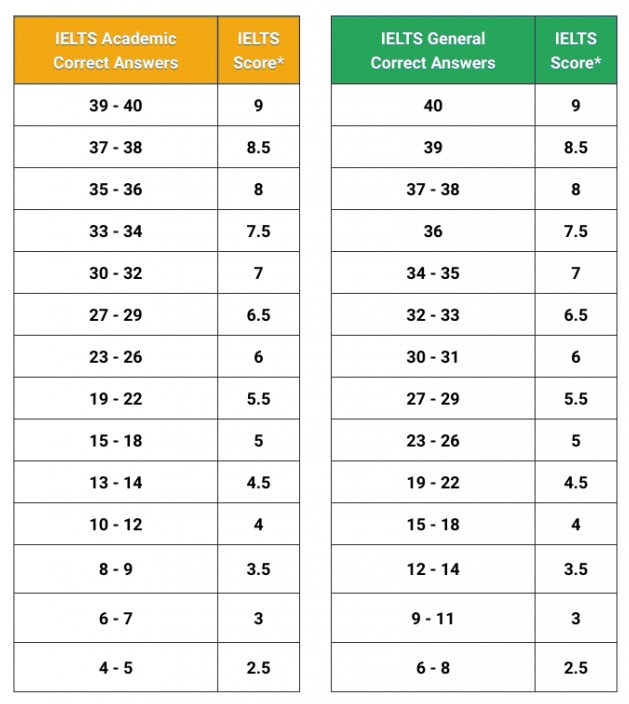By doing IELTS Academic a Study Visa would be granted.
IELTS- GT Test is commonly taken by those who wish to migrate to other nations in search to work or to earn their livelihood. In this test, generally, your every-day and non-academic English is analyzed.
Later, after qualifying IELTS-GT test with appropriate scores, migration to an English speaking country is granted.
Initially, understanding the IELTS Listening pattern is important for both the Academic and GT test. The marking pattern of Listening for IELTS-Academic and GT is absolutely the same as mentioned ahead.
IELTS – Listening modules contains 40 questions for which associated audio is played in the form of multiple audio dips. By listening to the conversation, relatively correct answers are to be written on the question booklet. Later, in additional 10 minutes as transferring time, these answers are to be copied or emulated on the answer sheet. Lastly, at the time of checking raw scores out of 40 are generated as the count of correct answers. Afterward, these raw scores are checked for corresponding IELTS Bands ranging from 0 to 9. Certain slabs are marked of raw scores corresponding to the IELTS Bands.

In the beginning, it is required to understand the Reading pattern for both the types of IELTS test that is Academic or General Training as both are quite different from one another.
Although, the types of question remains same for both types of test that is T/F/NG, Gap fillings, question/Answer, MCQs, Match the columns, List of headings, sentence completion etcetera. One score is marked corresponding to one correct answer.
In reading-Academic generally 3 Passages are given from professional and academic journals, textbooks, relevant magazines, documentaries, newspapers etc.
While those of Reading –GT contains 3 sections, Where the first two are divided further into two divisions and the texts are generally based on advertisements, guidebooks, magazines, notices or employee manuals etcetera.
Reading Answers are recommended to be transferred simultaneously because no etcetera time is allotted for transferring the answers unlikely the listening test.
Later, After checking the answers for the reading modules raw scores are generated, and then, these are matched with the corresponding IELTS bands ranging from 0 to 9. Certain slabs are marked for the raw scores corresponding to the IELTS Bands provided both IELTS-Academic reading and General Training Varies from one another.
Reading Bands Calculators are attached along with
IELTS Writing Test comprises of two varied tasks to represent the writing skills within a specific time foundation of 1 hour to cover up both the tasks. Both the tasks are generally marked by two different examiners or sometimes more examiners mark your writing test to ensure accuracy and fairness. These trainers are commonly intensively trained and monitored to ensure consistency, quality of marking, and unbiased scores, no matter from which part of the world the test is taken. The parameters of marking Task 1 and Task 2 are as described in the writing band descriptors.
 How is the IELTS Speaking module marked?
How is the IELTS Speaking module marked?Initially, there are 3 parts of the IELTS Speaking Test comprising of Introductory Questions
- Monologue Long Turn
- Follow up Questions
Speaking parameters are quite rigid in evaluating the speaking skills. Owing to assist you with these parameters, a speaking band descriptor is provided.

The overall band score is the average of the scores from all the four modules, rounded to the nearest whole or half band. All four modules are calculated out of 9 Bands.
If the average of the scores ends up with 0.25 then the overall band score is rounded up to the next half band.
If the average of the scores ends up with 0.75 then the overall Band score is rounded up to the next whole band.
For instance
1. Listening – 6.5
Reading – 6.5
Writing – 5
Speaking – 7
25.0
Divide by 4 = 25/4 = 6.25
Round off to the next half band
Overall – 6.5
2. Listening – 6.5
Reading – 6.5
Writing – 5.5
Speaking – 6.0
24.5
Divide by 4 = 24.5/4 = 6.125
Round off to the whole band as it is less than 0.25
Overall = 6
3. Listening – 4
Reading – 3.5
Writing – 4
Speaking – 4
19.5
Divide by 4 = 19.5/4 = 3.875
Fraction is above . 75 so round off to next whole band
Overall = 4
Listening 4 Reading 4 Speaking 2 Writing 2 How much score overall